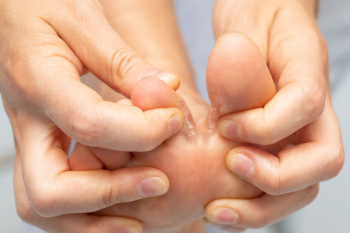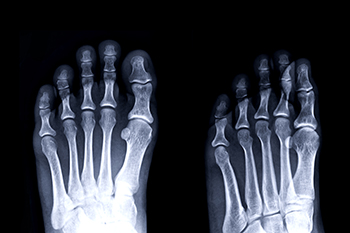Connect With Us
Blog

Athlete’s foot is a frequent fungal infection that usually begins between the toes but can spread if left untreated. When the skin cracks or peels, bacteria can enter, leading to secondary infections that may cause redness, swelling, and pain. In severe cases, these infections can spread to the toenails, resulting in thickened, discolored nails that are difficult to treat. For people with diabetes or poor circulation, untreated athlete’s foot can cause serious complications, including ulcers or cellulitis, a deep skin infection that may require antibiotics. The condition can also spread to the hands or other areas of the body through scratching or contaminated surfaces. Keeping feet clean and dry, changing socks regularly, and using antifungal treatments early can help prevent these complications. If your symptoms persist or worsen, it is suggested you see a podiatrist for diagnosis and appropriate treatment.
Athlete’s foot is an inconvenient condition that can be easily reduced with the proper treatment. If you have any concerns about your feet and ankles, contact one of our podiatrists from Whitestone Podiatry PC. Our doctors will treat your foot and ankle needs.
Athlete’s Foot: The Sole Story
Athlete's foot, also known as tinea pedis, can be an extremely contagious foot infection. It is commonly contracted in public changing areas and bathrooms, dormitory style living quarters, around locker rooms and public swimming pools, or anywhere your feet often come into contact with other people.
Solutions to Combat Athlete’s Foot
- Hydrate your feet by using lotion
- Exfoliate
- Buff off nails
- Use of anti-fungal products
- Examine your feet and visit your doctor if any suspicious blisters or cuts develop
Athlete’s foot can cause many irritating symptoms such as dry and flaking skin, itching, and redness. Some more severe symptoms can include bleeding and cracked skin, intense itching and burning, and even pain when walking. In the worst cases, Athlete’s foot can cause blistering as well. Speak to your podiatrist for a better understanding of the different causes of Athlete’s foot, as well as help in determining which treatment options are best for you.
If you have any questions please feel free to contact our office located in Whitestone, NY . We offer the newest diagnostic and treatment technologies for all your foot and ankle needs.

Symphalangism is a rare condition where the joints between certain bones are fused, limiting normal movement. In the feet, it often affects the toe joints, most commonly the middle joint of a toe, and results in stiffness and reduced flexibility. Causes may be genetic, as the condition is usually inherited, although it can also develop from abnormal bone growth. Symptoms include rigid toes that do not bend, discomfort while walking, difficulty finding comfortable shoes, and, in some cases, pain from pressure or altered gait. A podiatrist can help by evaluating the severity of the condition, recommending custom orthotics, providing supportive footwear advice, and offering treatment to reduce discomfort. If you have stiff or immobile toes, it is suggested that you consult a podiatrist who can accurately diagnose and offer relief solutions for what may be going on.
Some foot conditions may require additional professional care. If you have any concerns, contact one of our podiatrists of Whitestone Podiatry PC. Our doctors can provide the care you need to keep you pain-free and on your feet.
Rare Foot Conditions
The majority of foot conditions are common and can be treated by a podiatrist. Standard diagnostic procedures are generally used to identify specific conditions and treatment can be rendered. A podiatrist also treats rare foot conditions which can be difficult to diagnose and may need extra attention and care.
There are many rare foot conditions that can affect children. Some of these can include:
- Freiberg’s disease
- Kohler’s disease
- Maffucci syndrome
Freiberg’s disease - This can be seen as a deterioration and flattening of a metatarsal bone that exists in the ball of the foot. It typically affects pre-teen and teenage girls, but can affect anyone at any age. Symptoms that can accompany this can be swelling, stiffness, and the patient may limp.
Kohler’s disease - This often targets the bone in the arch of the foot and affects younger boys. It can lead to an interruption of the blood supply which ultimately can lead to bone deterioration. The patient may limp or experience tenderness, swelling, and redness.
Maffucci syndrome - This affects the long bones in a child’s foot leading to the development of abnormal bone lesions. They are benign growths and typically develop in early childhood and the bones may be susceptible to breaking.
A podiatrist can properly diagnose and treat all types of rare foot conditions. If your child is affected by any of these symptoms or conditions, please don’t hesitate to call our office so the correct treatment method can begin.
If you have any questions, please feel free to contact our office located in Whitestone, NY . We offer the newest diagnostic and treatment technologies for all your foot care needs.

A plantar fibroma is a firm, noncancerous growth that forms within the plantar fascia, the thick band of tissue along the bottom of the foot. It can cause pain, discomfort, and difficulty walking, especially when pressure is applied. When conservative treatments fail, surgery may be recommended to remove the fibroma and relieve tension on the surrounding tissue. The procedure involves making an incision in the sole of the foot to carefully remove the fibrous mass while preserving healthy structures. A podiatrist can evaluate the condition, recommend appropriate treatment, and guide recovery after surgery. If you have a plantar fibroma, it is suggested that you consult a podiatrist who can discuss treatment options with you, which may include surgery for permanent removal.
Foot surgery is sometimes necessary to treat a foot ailment. To learn more, contact one of our podiatrists of Whitestone Podiatry PC. Our doctors will assist you with all of your foot and ankle needs.
When Is Surgery Necessary?
Foot and ankle surgery is generally reserved for cases in which less invasive, conservative procedures have failed to alleviate the problem. Some of the cases in which surgery may be necessary include:
- Removing foot deformities like bunions and bone spurs
- Severe arthritis that has caused bone issues
- Cosmetic reconstruction
What Types of Surgery Are There?
The type of surgery you receive will depend on the nature of the problem you have. Some of the possible surgeries include:
- Bunionectomy for painful bunions
- Surgical fusion for realignment of bones
- Neuropathy decompression surgery to treat nerve damage
Benefits of Surgery
Although surgery is usually a last resort, it can provide more complete pain relief compared to non-surgical methods and may allow you to finally resume full activity.
Surgical techniques have also become increasingly sophisticated. Techniques like endoscopic surgery allow for smaller incisions and faster recovery times.
If you have any questions, please feel free to contact our office located in Whitestone, NY . We offer the newest diagnostic and treatment technologies for all your foot care needs.

